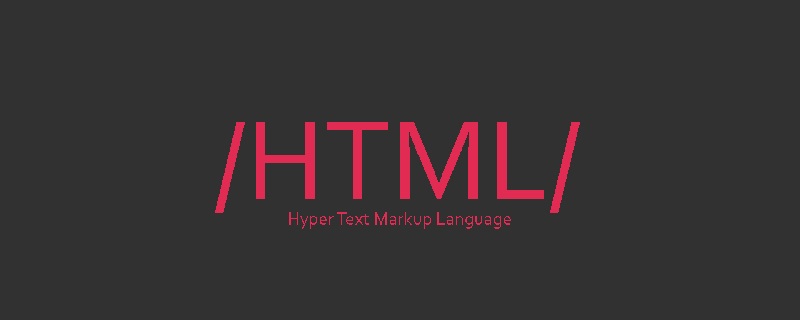HTML responsive layout refers to the use of front-end technologies such as HTML and CSS to enable web pages to automatically adjust layout and display effects according to the screen size and resolution of different devices to adapt to browsing on various terminal devices. Its purpose is to provide a consistent and high-quality user experience, regardless of whether users are accessing the web on a desktop computer, tablet, or mobile phone. This layout method can provide a better user experience, enable web pages to adapt to the screen sizes and resolutions of different devices, and improve the accessibility and usability of web pages.

The operating system for this tutorial: Windows 10 system, DELL G3 computer.
HTML responsive layout refers to the use of front-end technologies such as HTML and CSS to enable web pages to automatically adjust layout and display effects according to the screen size and resolution of different devices to adapt to browsing on various terminal devices. Its purpose is to provide a consistent and high-quality user experience, regardless of whether users are accessing the web on a desktop computer, tablet, or mobile phone.
The implementation of HTML responsive layout relies on the following key technologies and principles:
1. Flexible grid layout (Fluid Grid Layout): Flexible grid layout is the basis of responsive layout . By using relative units (such as percentages) to define the width of the grid, elements in the web page can automatically adjust their position and size according to the size of the grid. In HTML, you can use CSS Grid Layout or Flexbox Layout to implement flexible grid layout.
2. Media Queries: Media queries are one of the key technologies of responsive layout. By using the media query function of CSS, you can apply different style rules based on different media types (such as screen, printer, etc.) and different media characteristics (such as screen width, device orientation, etc.). By setting different media query conditions, you can provide different layouts and styles for different devices, thereby achieving adaptive effects.
3. Flexible Images and Media: In a responsive layout, the size of images and media elements also need to adapt to the screen size. To achieve this, you can use the CSS max-width property to set the maximum width of images and media elements so that they automatically shrink on small screens without exceeding the screen boundaries. This ensures that images and media elements display properly on different devices and provides a good user experience.
4. Breakpoints: Breakpoints refer to critical points for switching layouts under different screen sizes. By setting breakpoints, you can switch different layouts and styles according to changes in screen width. Usually, responsive layout switches the layout at different breakpoints such as small screen, medium screen and large screen. By setting breakpoints appropriately, you can ensure a good user experience across different screen sizes.
5. Progressive Enhancement: One of the design principles of responsive layout is progressive enhancement. Progressive enhancement refers to first providing a good browsing experience for basic devices, and then gradually adding more complex layouts and functions. This ensures that you can still browse the web normally on devices that don't support responsive layout. Through progressive enhancement, we can take into account the browsing needs of different devices and provide a consistent and high-quality user experience.
In actual development, CSS frameworks (such as Bootstrap, Foundation, etc.) can be used to simplify the implementation of responsive layout. These frameworks provide a set of already designed grid systems and style rules. Developers only need to configure and customize them as needed to quickly build responsive web pages.
In general, HTML responsive layout enables web pages to adapt to the screen sizes and resolutions of different devices through technical means such as flexible grid layout, media queries, flexible images and media, breakpoints and progressive enhancement. Automatically adjust layout and display effects. This layout method can provide a better user experience, enable web pages to adapt to the screen sizes and resolutions of different devices, and improve the accessibility and usability of web pages.
The above is the detailed content of What is html responsive layout. For more information, please follow other related articles on the PHP Chinese website!
 HTML超文本标记语言--超在那里?(文档分析)Aug 02, 2022 pm 06:04 PM
HTML超文本标记语言--超在那里?(文档分析)Aug 02, 2022 pm 06:04 PM本篇文章带大家了解一下HTML(超文本标记语言),介绍一下HTML的本质,HTML文档的结构、HTML文档的基本标签和图像标签、列表、表格标签、媒体元素、表单,希望对大家有所帮助!
 html和css算编程语言吗Sep 21, 2022 pm 04:09 PM
html和css算编程语言吗Sep 21, 2022 pm 04:09 PM不算。html是一种用来告知浏览器如何组织页面的标记语言,而CSS是一种用来表现HTML或XML等文件样式的样式设计语言;html和css不具备很强的逻辑性和流程控制功能,缺乏灵活性,且html和css不能按照人类的设计对一件工作进行重复的循环,直至得到让人类满意的答案。
 web前端笔试题库之HTML篇Apr 21, 2022 am 11:56 AM
web前端笔试题库之HTML篇Apr 21, 2022 am 11:56 AM总结了一些web前端面试(笔试)题分享给大家,本篇文章就先给大家分享HTML部分的笔试题(附答案),大家可以自己做做,看看能答对几个!
 HTML5中画布标签是什么May 18, 2022 pm 04:55 PM
HTML5中画布标签是什么May 18, 2022 pm 04:55 PMHTML5中画布标签是“<canvas>”。canvas标签用于图形的绘制,它只是一个矩形的图形容器,绘制图形必须通过脚本(通常是JavaScript)来完成;开发者可利用多种js方法来在canvas中绘制路径、盒、圆、字符以及添加图像等。
 html中document是什么Jun 17, 2022 pm 04:18 PM
html中document是什么Jun 17, 2022 pm 04:18 PM在html中,document是文档对象的意思,代表浏览器窗口的文档;document对象是window对象的子对象,所以可通过“window.document”属性对其进行访问,每个载入浏览器的HTML文档都会成为Document对象。
 html5废弃了哪个列表标签Jun 01, 2022 pm 06:32 PM
html5废弃了哪个列表标签Jun 01, 2022 pm 06:32 PMhtml5废弃了dir列表标签。dir标签被用来定义目录列表,一般和li标签配合使用,在dir标签对中通过li标签来设置列表项,语法“<dir><li>列表项值</li>...</dir>”。HTML5已经不支持dir,可使用ul标签取代。
 Html5怎么取消td边框May 18, 2022 pm 06:57 PM
Html5怎么取消td边框May 18, 2022 pm 06:57 PM3种取消方法:1、给td元素添加“border:none”无边框样式即可,语法“td{border:none}”。2、给td元素添加“border:0”样式,语法“td{border:0;}”,将td边框的宽度设置为0即可。3、给td元素添加“border:transparent”样式,语法“td{border:transparent;}”,将td边框的颜色设置为透明即可。

Hot AI Tools

Undresser.AI Undress
AI-powered app for creating realistic nude photos

AI Clothes Remover
Online AI tool for removing clothes from photos.

Undress AI Tool
Undress images for free

Clothoff.io
AI clothes remover

AI Hentai Generator
Generate AI Hentai for free.

Hot Article

Hot Tools

SublimeText3 Linux new version
SublimeText3 Linux latest version

WebStorm Mac version
Useful JavaScript development tools

Dreamweaver CS6
Visual web development tools

SAP NetWeaver Server Adapter for Eclipse
Integrate Eclipse with SAP NetWeaver application server.

SublimeText3 Chinese version
Chinese version, very easy to use







